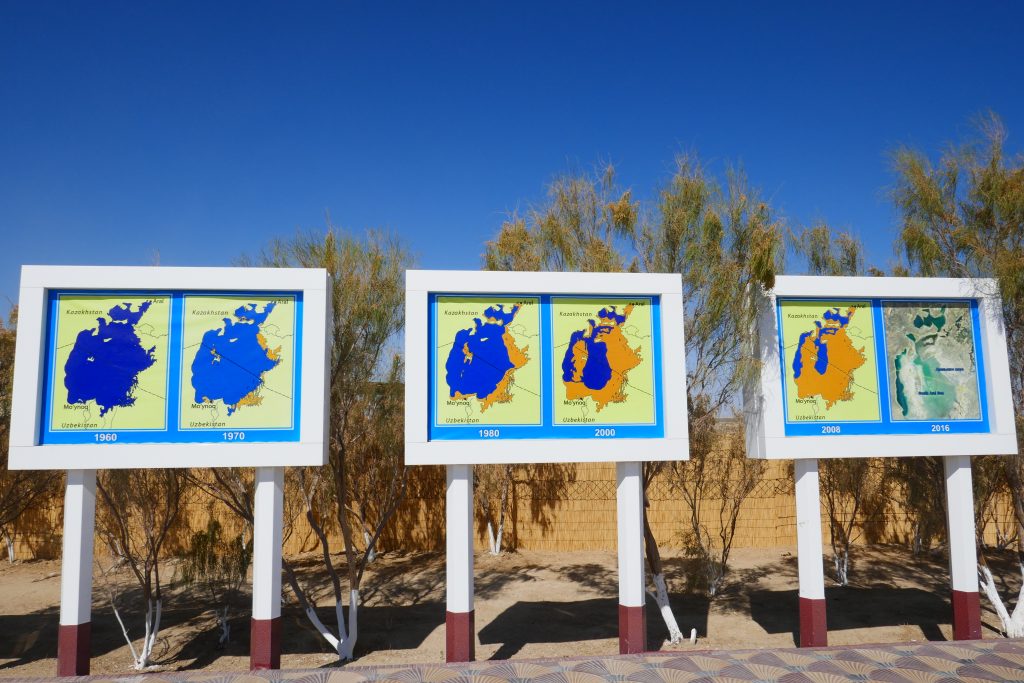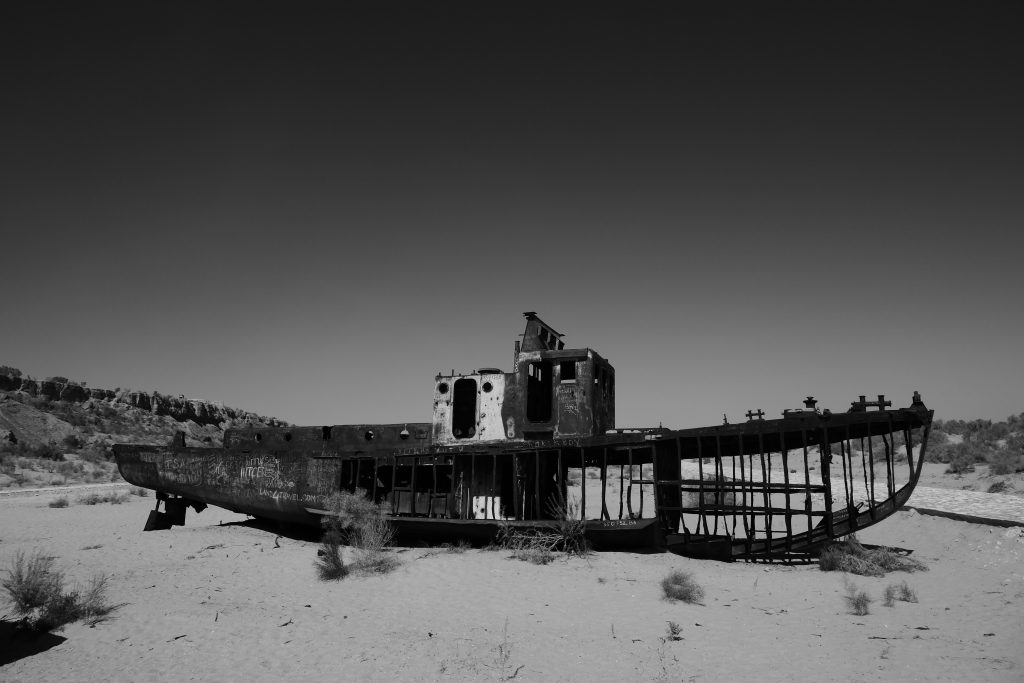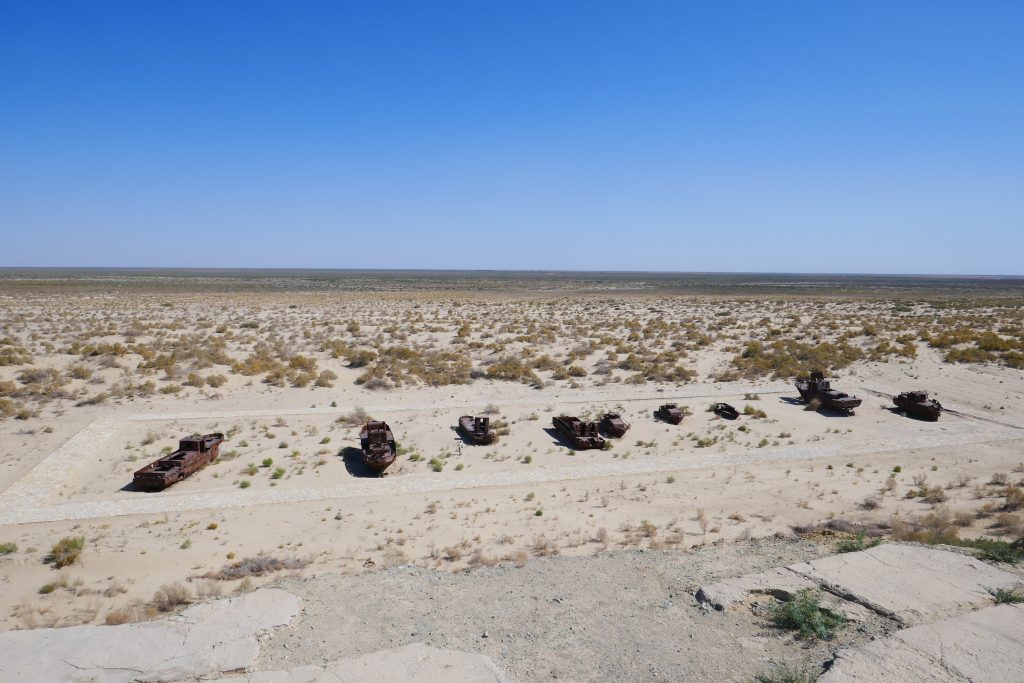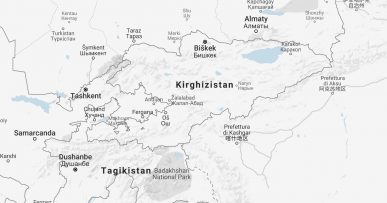A brief history of Nukus and the Aral Sea
Isolated and remote, Nukus remained for a long time just a little settlement in the middle of the desert. The city was developed just starting from the Soviet time and, thanks to its geographical position, it hosted the institute of chemical research of the red army. The Soviet influence is still very visible in the city, whose planimetry can be resumed in a bunch of wide roads and anonymous buildings. Due to its sovietic architecture, the city itself is not really appealing and it wouldn’t be a tourist destination if it wasn’t for the Stravinsky museum and the nearby Aral lake.
The Nukus museum of art or, in full, the State Art Museum of the Republic of Karakalpakstan named after I.V. Savitsky, is a museum based in Nukus opened in 1966 housing a wide collection of items from Khozarm to Uzbek art as well as the second largest collection of Russian avant-garde in the world. Painter, archaeologist and collector, Igor’ Fëdorovič Stravinskij (1882-1971) moved to Karakalpakstan (Nukus province) in the 50’s and assembled a large collection of pieces of art risking his life as “enemy of the people” due to the ban under the Stalin rule. The enormous effort and cultural contribution made by Stravinsky were not recognised until 1991, when Uzbekistan became independent and the “closed and remote” Nukus became accessible to the rest of the world.

Formerly the fourth largest lake in the world, the Aral lake has been progressively shrinking since 1960, when the rivers that fed it were diverted to irrigate the nearby cotton fields. Today, the southern part of the lake on the Uzbek side has almost totally disappeared and little has been done to stop the natural disaster. Contrarily, on the Kazakh side, dam projects were completed in 2005 and 2008 and the level of the Aral Sea has risen by 12 meter on the northern side compared to 2003. The limited number of fish due to the increased salinity of the water, the loss of jobs for the local population and the reduced harvests due to the salt deposited on the ground and spread by desert winds are just a few of the human and natural consequences of the disaster occurred in this area. Today, Moynaq, once flourishing fishing centre of Karakalpakstan, is just an anonymous village in the desert and the rusty fishing boats are gloomy memories of the past.

Our experience
We stayed just a couple of nights in Nukus at the Besqala hostel paying 12$ each per night. We arrived late in the afternoon from Khiva and we also argued with the taxi driver because he wanted extra money to bring us home, which is quite common in Uzbekistan if you get a share taxi. We thought it was probably a revenge because we made him wait for a wee while when we were in Khiva (see our article, Khiva: what to do in a couple of days). Despite being a bit more expensive than normal, the hostel was nice, the location was central, the staff and the environment was friendly. That night we went for dinner at Alpamis Milliy tag’amlar, a good, cheap and central restaurant recommended by the staff of the hostel…very good place for food if you go to Nukus. Back at the hostel, we met a few guests, we started chatting and we found out that an Australian guy called Eddie was going to Moynaq the day after by bus. We then decided to go all together.
To “see” the Aral lake on the Uzbek side you have two options, you either pay a lot of money for a tour or a taxi to get to the remaining part of the lake (it retracted by 220km so it’s a long long way from Nukus) or you take a local bus (or a taxi if you want) to the once coastal town of Moynaq. In the second case, you won’t see the lake but you will see the rusty fishing boats and it’s still very impressive imagining how that little village was surrounded by water just 60 years ago. Only one bus, departing from the western bus station, goes to Moynaq and come back Nukus. It takes 3:30/4hrs and costs 15000 som per person one way. Officially, the departures times are 9am and 3pm respectively from Nukus and Moynaq but the reality is that it departs when is full. Thus, go there WELL IN ADVANCE, from a minimum of 30 min to a maximum of one hour in order to get the seats otherwise you will stand the all time. Of course we didn’t know that, we arrived at the bus station in Nukus around 8:30am and the bus was already full, so we had to stand for almost 4 hours!

Arrived in Moynaq, we went straight to the “boat cemetery” as it’s called the once bed of Aral lake. It’s very easy to get there, you just need to take the only marshrutka going northward or stopping any car in that direction. Walking in the surreal silence of the desert, surrounded by old rusty fishing boats just makes you realised what are the limits of human stupidity and how catastrophic can be the consequences of it. We believe pictures say more than words in this case…




We completed the visit of Moynaq going to the museum of the Aral lake. The little museum contains a selection of pictures and paintings of Moynaq before the 1960s. Visitors can also enjoy the view of a short documentary about the Aral lake. Since it seems more a propaganda video rather than an objective documentary, the beauty of the video is debatable but the museum is still really nice to visit.
On the way back, we stopped at a cafe for lunch and as soon as we entered we were invited in the room next door where a large group of people were celebrating a birthday party of a local girl. At the beginning the environment was super friendly, everyone wanted to drink, dance or taking pictures with us. However, after 15 minutes, the husband of the girl who was celebrating her birthday, maybe irritated by the “excessive” physical contact Guido had with her girlfriend (he gave her a hug to wish her happy birthday) got pissed off and decided he had enough. He started saying that we had to go out, he threatened us, grabbed Eddie’s phone and started shouting at him as well. In fact, because he was angry with all of us, we don’t know exactly what annoyed him so much, probably he was just wasted drunk. However, we realised the cultural differences between us and how easily some behaviours that we consider “normal” can be misunderstood when you travel to certain countries, particularly in remote areas. Anyway, we left and we went to the bus station.

There, we immediately reserved the seats on the bus but, right before the bus departure (we arrived there 40 min before this time), a girl in her 20’s arrived and wanted our seats, probably because we were foreigners, claiming that she had reserved them in advance. However, she didn’t know how tough we are and, supported by some local ladies, we kept the seats and the bus departed without the girl who remained in Moynaq. The bus on the way back was extremely overcrowded and thank god we had the seats. You’d better go to the bus station very early if you don’t want to be massively squeezed for 4 hours in a bus without air conditioning! Back in Nukus we went with Eddie to the restaurant of the previous day and then to the hostel to have a shower, we deserved it!
The next day we went to the Stravinsky museum. It is composed of two parts, one includes sculptures, paintings, various Karakalpakstan and Uzbek objects or dresses; the other one is just paintings. You can either choose to visit one part or both and the cost is respectively 25000 or 35000 som per ticket. Both parts are very fascinating so we don’t recommend one more than the other one, it’s actually up to you what you want to see. However, when you choose, consider that Nukus it’s quite remote and probably won’t go back there any time soon! Here are some examples of pieces of art hosted in the Stravinsky museum.



Finally, the city of Nukus may not be beautiful but don’t miss its bazaar. Contrarily to some Uzbek bazaar, especially in tourist areas of Khiva, Samarkand or Bukhara, the bazaar in Nukus is authentic, vibrant and massive. Getting lost between the stands is fantastic and you will get the real feeling of a central Asian bazaar.


After the all day out, first at the museum and after at the bazaar, we went to the hostel and from there to get the overnight train to Samarkand (look at our journey in Uzbekistan for better information about how to get the train tickets). When we entered in our cabin, it was lovely. It was clean (they provide you beddings) and we were alone. However, after a couple of hours, two men entered the cabin and one of them was extremely drunk. He started being annoying with us, he then tried to smoke in the corridor but it was obviously forbidden so he insulted the train officer. Because of the misbehaviour, the police got into the train and wanted to arrest him (apparently in these cases in Uzbekistan you either go to jail for 15 days or you pay an extremely high fee) but eventually they didn’t and they just moved both the guys to another cabin. You may think that that was the end but it wasn’t! In fact, since two guys were moved, someone else came into our cabin and the train officer changed our companions not one, not two but three times in three hours time! Very, very confusing…
At 5am, totally knackered for lack of sleeping, we eventually arrived in Samarkand. We had great expectations about it but we knew it would have been extremely touristy and renovated. We will tell you all on our next article…




